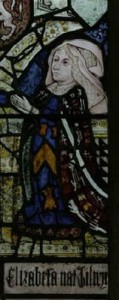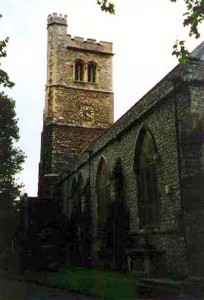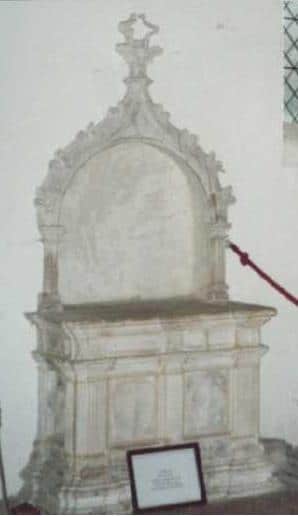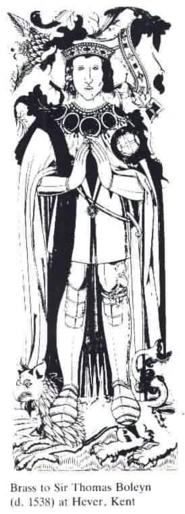
Now, that I have finished my series on Henry VIII and his change from virtuous prince to tyrant, I thought it would be good to look at the Boleyn family. Today’s post is on Elizabeth Boleyn (née Howard) and is a guest post from Anne Boleyn Files visitor Sheena Reekie – thanks Sheena!
Elizabeth Boleyn
by Sheena Reekie
There are many people in history whose stories have been lost in time. Although we know about the exploits of Thomas, Mary, George, and Anne Boleyn, by all accounts little is known about the wife and mother of the infamous Boleyn family. How did she feel about her daughter Mary’s reputation? Did she support Anne’s relationship with Henry VIII? Did she watch her children’s executions at the Tower? What happened to her in the aftermath of the scandal that ruined her family? Just who was Elizabeth Boleyn?
Background and childhood
Elizabeth Howard was born sometime between 1480-1486 at Arundel Castle in Sussex. She was the eldest daughter of Thomas Howard, 2nd Duke of Norfolk, by his first wife Elizabeth Tilney. Through her father, she was a direct descendant of King Edward I1. Despite being a member of the prestigious Howard family, there is surprisingly very little known about Elizabeth.

After the defeat of King Richard III (who was killed at the Battle of Bosworth and supplanted by Henry VII), the Howard family gained favor with the new monarch and had their titles restored to them in 1514. As was typical of noble families, when Elizabeth was a young girl, she was sent to court to serve in the household of Elizabeth of York.
Life at court
After the death of Henry VII, Elizabeth remained in the royal household and began serving as lady-in-waiting to Catherine of Aragon. Historically recorded as being an attractive woman2, rumors circulated that Henry VIII once had a dalliance with Elizabeth Boleyn after he came to the throne3. Many historians tend to discount this claim due to the fact that Henry did not mention any affair with Elizabeth when he filed for his dispensation to make his marriage to Anne lawful. When it was claimed that Henry had had an affair with both Anne’s sister and mother, the king is said to have replied to the rumors, “Never with the mother.” Elizabeth did, however, catch the eye of an ambitious member of court by the name of Thomas Boleyn.
Wife and mother
Sometime between 1498-14994, Elizabeth wed Thomas, a young courtier and diplomat who was also serving in the court of Henry VII. Through their union, Elizabeth gained the titles of Countess of Ormond and Viscountess Rochford5.
According to the writings of Thomas Boleyn, Elizabeth was pregnant many times in the first few years of their marriage. It is believed that she had 5 pregnancies, of which 3 of her children (Mary, George, and Anne) survived to adulthood.
Between 1518-1521, the Boleyns were living in France, where Thomas was serving as English ambassador. It is at this time that her daughters, Mary and Anne were serving in the French court as ladies-in-waiting to Queen Claude.

According to historian M.L. Bruce, both Thomas and Elizabeth developed “feelings of dislike” for their daughter Mary in the wake of her affair with King Francis of France. Later, the papal nuncio in France, would record that the French monarch had referred to Mary as, “my English mare”; and later in his life described her as “a great wh*re, the most infamous of all6. In the attempt to clear her name, Thomas and Elizabeth arranged a marriage between Mary and Sir William Carey, a court courier and favorite of Henry VIII7. This would later backfire, as Mary would become mistress to Henry VIII. After the death of her first husband, Mary eloped with commoner, William Stafford, in 1535. Elizabeth Boleyn sided with the rest of the family and banished Mary from court for breaching royal etiquette8.

As opposed to Mary, Anne enjoyed a close relationship with her mother. Elizabeth had been in charge of her children’s early education and is said to have taught music and religion, reading, writing, and embroidery, of which Anne embraced9. When Anne began her relationship with Henry, it was Elizabeth who accompanied Anne to court, and kept a watchful eye on her daughter. She would remain a part of Anne’s royal household and is even believed to be the namesake of Anne and Henry’s daughter, the future Queen Elizabeth I.
The Fall of Anne Boleyn
It is unknown how Elizabeth felt in the wake of the scandal that would lead to the execution of two of her children, the stripping of her husband’s titles, and the bastardization of her grand-daughter. It is also unknown if she witnessed their beheadings. What is known is that she quietly retired to the English countryside, and died April 3, 1538 at Abbot of Readings place, Baynard’s Castle. She is buried in the Howard Family Chapel at St. Mary’s in Lambeth Cemetery.
Controversies of Elizabeth Boleyn
- She did not die in 1538, she died in 1512 – It is probable that this inaccuracy was run as fact in earlier biographies by authors like Agnes Strickland (Lives of the Queens of England- 1840-1848) and Hester Chapman (Challenge of Anne Boleyn -1974). Henry Howard (a later relative) printed the “Howard Memorials” in 1834 and lists Elizabeth’s death in 1512 from complications due to childbirth. It is possible that he confused this with her sister, Lady Muriel Howard, who was married to Sir Thomas Knyvett and really did die in childbirth in 1512. Her Oxford Dictionary of National Biography entry is 3 April 1538.
- Thomas Boleyn remarried which is why there is no direct reference to his wife, “Elizabeth”
-If Elizabeth had died in 1512, it would be highly unlikely that Thomas Boleyn’s second wife would have been of lower birth, considering that he was in favor with Henry VIII in 1512 (in 1512, he was one in a part of 3 envoys to the Netherlands). Also, nobles would have been called by their titles, so if there was reference to Elizabeth, it would have been by the title, “Countess of Ormond” or “Viscountess Rochford.” - She was one of Henry VIII’s mistresses – As stated earlier, Henry never made mention of having relations with Elizabeth Boleyn when he petitioned for his papal dispensation to marry Anne. It is possible that Elizabeth Boleyn is being confused with Elizabeth Blount, who if officially recognized as one of Henry VIII’s mistresses. There is belief that this rumor was started in the wake of the fall of the Boleyns to bring more shame upon their family.
- Thomas and Elizabeth did not have a happy marriage – It was typical of women of the time to be buried with their husbands. In the aftermath of the annihilation of her family, it is quite possible that there was a falling out between Elizabeth and Thomas. This would explain why she is buried in the Howard family tomb vice in the Boleyn family tomb.

Notes and Sources
- “The Six Wives of Henry VIII”, by Antonia Fraser, p. 116 (1992).
- “Anne Boleyn,” by Marie-Louise Bruce, p. 13 (1972).
- “The Mistresses of Henry VIII” by Kelly Hart, p.118 (2009)
- “The Life and Death of Anne Boleyn”, by Eric Ives, p.17 (2004).
- “Henry VII”, by Stanley Bertram Chrimes, pg 138 (1999)
- “Anne Boleyn,” by Marie-Louise Bruce, p. 23 (1982).
- “Henry VIII: The King and His Court” by Allison Weir, p. 216.(2001)
- “The Six Wives of Henry VIII,” by Alison Weir, p. 273 (1991).
- “The Six Wives of Henry VIII,” by Alison Weir, p. 148 (1991).

